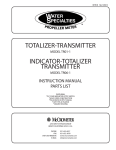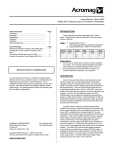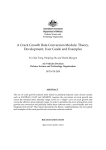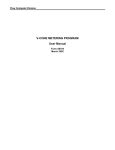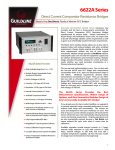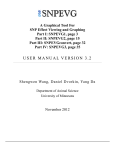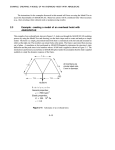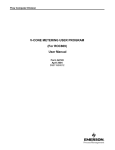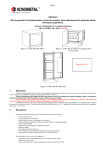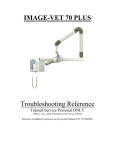Download totalizer-transmitter indicator-totalizer transmitter
Transcript
30119-33 TOTALIZER-TRANSMITTER MODEL TR15 INDICATOR-TOTALIZER TRANSMITTER MODEL TR16 OPERATION AND MAINTENANCE MANUAL PARTS LIST FEATURING: *P/C CARD MOUNTED OPTIC SWITCH *SOLID STATE CONSTRUCTION *CURRENT OUTPUT SIGNAL *CUB TYPE ACTUATOR *SEALED HOUSING OUTPUT SIGNAL *CUP TYPE ACTUATOR *SEALED HOUSING 3255 WEST STETSON AVENUE HEMET, CALIFORNIA 92545 U.S.A. PHONE: FAX: VISIT OUR WEBSITE: 951-652-6811 951-652-3078 www.mccrometer.com Rev. 1.7/07-06 30119-33 Rev. 1.7/07-06 WARRANTY This Warranty shall apply to and be limited to the original purchaser consumer of any McCrometer product. Meters or instruments defective because of faulty material or workmanship will be repaired or replaced, at the option of McCrometer, free of charge, FOB the factory in Hemet, California, within a period of one (1) year from the date of delivery. Repairs or modifications by others than McCrometer or their authorized representatives shall render this Warranty null and void in the event that factory examination reveals that such repair or modification was detrimental to the meter or instrument. Any deviations from the factory calibration require notification in writing to McCrometer of such recalibrations or this Warranty shall be voided. In case of a claim under this Warranty, the claimant is instructed to contact McCrometer, 3255 W. Stetson Ave., Hemet, California 92545, and to provide an identification or description of the meter or instrument, the date of delivery, and the nature of the problem. The Warranty provided above is the only Warranty made by McCrometer with respect to its products or any parts thereof and is made expressly in lieu of any other warranties, by course of dealing, usages of trade or otherwise, expressed or implied, including but not limited to any implied warranties of fitness for any particular purpose or of merchantability under the uniform commercial code. It is agreed this Warranty is in lieu of and buyer hereby waives all other warranties, guarantees or liabilities arising by law or otherwise. Seller shall not incur any other obligations or liabilities or be liable to buyer, or any customer of buyer for any anticipated or lost profits, incidental or consequential damages, or any other losses or expenses incurred by reason of the purchase, installation, repair, use or misuse by buyer or third parties of its products (including any parts repaired or replaced); and seller does not authorize any person to assume for seller any other liability in connection with the products or parts thereof. This Warranty cannot be extended, altered or varied except by a written instrument signed by seller and buyer. This Warranty gives you specific legal rights, and you may also have other rights which vary from state to state. McCrometer reserves the right to make improvements and repairs on product components which are beyond the Warranty period at the manufacturer’s option and expense, without obligation to renew the expired Warranty on the components or on the entire unit. Due to the rapid advancement of meter design technology, McCrometer reserves the right to make improvements in design and material without prior notice to the trade. All sales and all agreements in relation to sales shall be deemed made at the manufacturer’s place of business in Hemet, California and any dispute arising from any sale or agreement shall be interpreted under the laws of the State of California. Copyright © 2006 McCrometer. All written material should not be changed or altered without permission of McCrometer. The published technical data and instructions is subject to change without notice. Contact your McCrometer representative for current technical data and instructions. 2 30119-33 MODEL TR15 TOTALIZER-TRANSMITTER 6. 7. 8. 9. 10. 11. MODEL TR16 INDICATOR-TOTALIZER-TRANSMITTER INDEX I. DESCRIPTION Rev. 1.7/07-06 Transmitter Base Drive Clevis Switch Actuator Transmitter Communication Lines Printed Circuit Card Replacing Printed Circuit Card XII. INSPECTION II. SPECIFICATIONS XIII. REASSEMBLY 1. Before Return of Transmitter III. UNPACKING IV. INSTALLATION 1. Remove 2. Clean Meter Head 3. Totalizer Drive Magnet 4. Indicator Drive Gear 5. Transmitter Drive Gear 6. Vertical Shaft 7. Replacement Vertical Shaft 8. Adapter Plate 9. Transmitter Drive Clevis 10. Transmitter Base O-Ring 11. Position of Transmitter 12. Transmitter Wiring XIV. INOPERATIVE INSTRUMENT EVALUATION 1. Check All Instruments and Transmitters 2. Check Your Instrument 3. Transmitter or Communication Line 4. Full Scale Output 5. Communication Problems 6. Separation of Signal and Power I. DESCRIPTION MODEL TR15 TOTALIZER-TRANSMITTERS provide a totalization of flow volume and pulse output. V. SERVICE MANUAL VI. WORKING AREA MODEL TR16 INDICATOR-TOTALIZER TRANSMITTERS provide an instantaneous flow rate indication and totalization of flow volume. VII. TOTALIZER ASSEMBLY 1. Bonnet Mounting Screws 2. Totalizer 3. Totalizer Change Gears 4. Totalizer Drive Magnet Assembly Both transmitters provide a pulse rate output signal proportional to the rate of flow when mounted on our propeller meters. II. ‡VIII. INDICATOR-TOTALIZER ‡1. Bonnet Mounting Screws ‡2. Indicator Mounting Screws ‡3. Meter Change Gears ‡4. Indicator-Totalizer ‡5. Gears SPECIFICATIONS ACCURACY Current output: plus or minus .5% of full scale of the instrument the transmitter is controlling. Accuracy of current output can be increased but will cause a slower response. Pulse output: plus or minus 2.0% of actual flow within the range specified for each meter size. TEMPERATURE RANGE 140° F Maximum. Consult factory for special construction for higher temperatures. POWER SUPPLY 24 VDC (as supplied by our power supply Model IN36-1) wired in series with mA output and instrument. The mA output must be powered in order to use the pulse output. IX. INSPECTION X. REASSEMBLY 1. Totalizer Drive Magnet Assembly 2. Totalizer Base Cup 3. Bonnet Assembly ‡4. Change Gears ‡5. Indicator-Totalizer ‡6. Bonnet Assembly XI. TROUBLE-SHOOTING 1. Trouble-Shooting Guide 2. Working Area 3. Totalizer or Indicator-Totalizer 4. Moisture 5. Driven Clevis Shaft ‡ For Indicator-Totalizers Only Note: Maximum current consumption of transmitter is 4-20 mA. 3 30119-33 Rev. 1.7/07-06 FLOW RANGE Acceptable for each transmitter unit is the same as that for the meter to which the unit mounts. MATERIALS Used in construction are chosen for their durability and immunity to the corrosive effects of atmospheric moisture and the liquids measured by the meter assembly. OUTPUT SIGNAL SHIPPING WEIGHT The shipping carton contains the following items: Model TR15 or TR16 .............................................. 1 Base O-Ring ............................................................. 1 Mounting Screws .................................................... 4 Vertical Shaft Clevis ................................................ 1 Clevis Coupling ........................................................ 1 Operation and Maintenance Manual ........................ 1 IV. INSTALLATION of transmitters is normally done at the factory when the meter is assembled, but may be made in the field with the meter stopped (i.e. no flow). Depending upon what situation exists, various steps for installation apply and the procedures are outlined below. Current signal: 4-20 mA sourcing type (with loop impedance of 175Ω to 1075Ω), true two wire with external power supply. Pulse rate: two wire scaled pulse rate output. (Customer specified pulse rate, 600 PPM max.) The maximum recommended distance for pulse output transmission is 5000 feet. Pulse Output Ratings Maximums are for signals between P2 and P1 Voltage: 18 VDC Current: 60 mA DC Power dissipation: 100 mW Note: Unit utilizes an open collector transistor output. 35 VDC reverse voltage polarity protection. 1. REMOVE the existing totalizer or indicator or transmitter by removing all the mounting screws and lifting the unit off the meter head. 2. CLEAN METER HEAD of all dirt, glue, gaskets and other foreign material. 3. TOTALIZER DRIVE MAGNET must be removed from the vertical shaft tip of meters equipped with a totalizer so that the transmitter drive clevis (#35) can be installed on the vertical shaft tip. The totalizer drive magnet can be removed by loosening the set screw in the side of the magnet hub and sliding the assembly off the vertical shaft. 4. INDICATOR DRIVE GEAR must be removed from the vertical shaft tip of meters equipped with indicator-totalizers so that the transmitter drive clevis (#35) can be installed on the vertical shaft tip. The indicator drive gear can be removed by loosening the set screw in the side of the gear hub and sliding the assembly off the vertical shaft. 4 pounds OPTIONAL EQUIPMENT Includes non-reversing ratchet, special outputs (consult factory for special applications). ORDERING INFO Must be specified by the customer and includes: Serial number of meter unit is to be mounted on, Maximum scale range required for pulse output, Change gears and type of dial on totalizer that is going to be replaced. 5. TRANSMITTER DRIVE GEAR must be removed from the vertical shaft of meters equipped with an old style McCrometer Model TR01 or TR06. The transmitter drive gear can be removed by loosening the set screw in the side of the gear hub and sliding the assembly off the vertical shaft. 6. VERTICAL SHAFT assembly must be removed from the meters equipped with an old style McCrometer CN06 indicator, TR01 or TR06 transmitter (.100" dia. vertical shaft tip) and replaced with a vertical shaft that has a 3/16" diameter tip. Vertical shaft removal can be accomplished by removing the two vertical shaft collar bearing mounting screws in the meter head and pulling the vertical shaft directly out of the top of the meter. Remove the vertical shaft collar and bearing assembly from the vertical shaft by loosening the set screw in the side of the collar and sliding the assembly off the vertical shaft. III. UNPACKING. When unpacking the transmitter, any damage due to rough or improper handling should be immediately reported to the transportation firm and McCrometer. If for any reason, it is determined that the unit or parts of the unit should be returned to the factory, please contact McCrometer for clearance prior to shipment. Each unit must be properly packaged to prevent any further damage. The factory assumes no responsibility for equipment damaged in return shipment due to improper packaging. Proper paper work must be enclosed with any returned material. 7. REPLACEMENT VERTICAL SHAFT for meters with old style McCrometer models CN06 indicators, TR01 or TR06 transmitters, should be inspected to be sure it is not bent or damaged. Install the vertical shaft collar and bearing assembly on the new (3/16" diameter tip) vertical shaft, 4 30119-33 TRANSMITTER OPERATION AND MAINTENANCE MANUAL but do not tighten the collar bearing set screw yet. Insert the vertical shaft assembly, plastic tip first, into the meter head and rotate the shaft gently until it is engaged in the driven miter gear shaft of the miter gear frame assembly. Set the collar and bearing assembly into the hole in the meter head and replace and secure the two screws that hold the collar bearing in place. Do not over tighten the screws or the bearing can cock and cause drag. Turn the vertical shaft to check for bind or drag. Note: If the meter is in a pipeline full of water, then a slight drag will be created by the propeller moving through the water. Should any bind or drag be apparent it can usually be corrected by adjusting the vertical shaft assembly. Slide the vertical shaft down until it rests against the driven miter gear shaft, then lift the vertical shaft up about 1/64 inch. Tighten the set screw in the side of the collar bearing assembly. V. MCCROMETER products have been carefully designed to be as maintenance free as possible. Periodic preventive maintenance, however, is highly recommended and should be practiced according to schedule to assure continuous accuracy and trouble free performance of your transmitter. The maintenance and inspection procedure can also be used as a guide to locating a problem in the unit that may be the cause of abnormal operation. VI. WORKING AREA chosen for cleaning and inspection of the internal components should be clean to reduce the chance of dust or dirt particles being introduced into the transmitter mechanism. 8. ADAPTER PLATE part number A-2-4108, and gasket part number 1558-3, must be attached to the top of the meter head on the old style McCrometer LP21 (3 hole bolt circle) and all ML45, 47 and 49 meters. The adapter plate can be secured to the meter head by three mounting screws (part number 1116-8-12) after the gasket has been centered on the head. Throughout the rest of the instruction manual, the top of the adapter ring will be referred to as the top of the meter head. VII. TOTALIZER ASSEMBLY (#4) service procedure should include cleaning and inspection of the unit noting any excessive wear on the change gears (#7 & #8) that may lead to operational problems in the unit. 1. BONNET MOUNTING SCREWS (#3) should be removed and the entire bonnet (#1) lifted off of the meter. 2. TOTALIZER is contained within the totalizer bonnet (#1) and held in place by a base cup (#5). It should not be necessary to remove the totalizer (#4) during inspection; however, removal of the base cup (#5) is necessary for inspection of the totalizer change gears (#7 & #8). Removal of the base cup (#5) can be accomplished by inserting a small screwdriver into the two cutouts and prying upward under the edge. 9. TRANSMITTER DRIVE CLEVIS (#35) must now be installed on the meter vertical shaft. Place the drive clevis (#35) on the vertical shaft with the forked end up. Position the drive clevis so that the top of the clevis is 1/8" below the top surface of the meter head (on non-reversing models the entire ratchet assembly should be placed on the vertical shaft and the measurement taken from the top of the forked portion). Place the plastic drive clevis coupling (#36) on top of the drive clevis (#35) with the forked portion of the drive clevis fully engaged in the slot in the clevis coupling (#36) and the larger diameter hole in the coupling (#36) facing up. 3. TOTALIZER CHANGE GEARS (#7 & #8) should be inspected for any sign of wear. Both the A-(drive) gear and B-(driven) gear are attached to the lower portion of the totalizer assembly (#4). Spin the floating totalizer driven magnet in the center of the totalizer bottom (#4) to make certain it spins freely without bind or drag. The bottom of the totalizer has the letter "A" molded next to the A-drive gear shaft, and the letter "B" next to the B-driven gear shaft. 10. TRANSMITTER BASE O-RING (#38) should be covered with a thin coat of silicone grease and placed in the oring groove in the bottom of the transmitter base (#11). 11. POSITION OF TRANSMITTER on top of the meter head can be made in one of four directions for the easiest possible reading. Normally the units are attached so that they can be read when looking upstream. Be sure the drive clevis (#35) is in proper alignment and makes a positive engagement with the clevis coupling (#36). Set the transmitter on the meter head and position the driven clevis shaft (#28) so that the slot in the clevis coupling (#36) is properly engaged with the cross pin in the driven clevis shaft (#28). Secure the four mounting screws (#37) . 4. TOTALIZER DRIVE MAGNET ASSEMBLY (#9) located in the transmitter base (#10) at the top of the driven clevis shaft (#28) should be checked and adjusted if necessary to position it 1/16 inch below the top surface of the transmitter base (#10). Adjustments can be made by loosening the socket head set screw in the side of the totalizer drive magnet assembly (#9), and sliding it up or down the driven clevis shaft (#28) as desired. Always be sure the set screw is tightened into the flat on the driven clevis shaft (#28). ‡VIII. INDICATOR-TOTALIZER service procedure should be practiced yearly and should include removal, cleaning and inspection of the unit noting any excessive wear on the gears and other wear points that may lead to operational problems in the unit. 12. TRANSMITTER WIRING can be accomplished by following the applicable wiring diagram on pages 13 and 14. ‡ For Indicator-Totalizers Only Rev. 1.7/07-06 5 30119-33 Rev. 1.7/07-06 ‡1. BONNET MOUNTING SCREWS (#2) located beneath the indicator-totalizer bonnet lid, should be removed and the entire bonnet (#1) lifted off of the transmitter. Replace the o-ring seals around each of the four screws (#3) and at the bottom of the bonnet (#4) and cover each of the new orings with a thin coat of silicone grease. cup (#5) properly. When reinstalling the cup (#5), put two drops of super glue on the inside edge of the bonnet 180° apart and push cup firmly into the bonnet and hold for 30 seconds. 3. BONNET ASSEMBLY (#1) should be cleaned and replaced on the transmitter (#10). Bonnet o-ring (#2) should be replaced and the new o-ring (#2) covered with a thin coat of silicone grease. Secure four screws (#3). ‡2. INDICATOR MOUNTING SCREWS (#6) and shakeproof washers (#7) holding the indicator-totalizer unit (#5) to the transmitter base (#10) should be removed and the unit lifted off, exposing the A-drive gear (#8) attached to the top of the driven clevis shaft (#28). ‡4. CHANGE GEARS (#8 & #9) should be checked again to make certain they are in proper alignment (see section VIII-3). The gear teeth should be lubricated with a light grease to assure longer life. ‡3. METER CHANGE GEARS (#8 & #9) should be inspected for any sign of wear. The A-(drive) gear (#8) is attached to the top of the driven clevis shaft (#28), and the B-(driven) gear (#9) is attached to the bottom of the indicator (#5). The position of the A-drive gear should be checked and adjusted if necessary to position the top face of the gear 1/8 inch below the top surface of the transmitter base (#10). The position of the B-driven gear top face should be 1/8 inch below the bottom of the indicator-totalizer. ‡5. INDICATOR TOTALIZER mechanism (#5) should be placed on the transmitter base (#10) with the mounting screws and shakeproof washers (#6 & #7). Do not tighten mounting screws (#6) until the gear mesh has been properly adjusted. To adjust gear mesh, slide the indicator-totalizer mechanism (#5) towards the A-drive gear (#8) until the unit stops because of full gear mesh. Now back off the indicator totalizer mechanism 1/64 inch and tighten mounting screws (#6). ‡4. INDICATOR-TOTALIZER unit (#5) should be cleaned thoroughly using a mild soap and a soft brush. Under no circumstances should the entire unit be immersed in the soap or should any metal object be used when cleaning and inspecting the internal parts of the indicator-totalizer unit. ‡6. BONNET ASSEMBLY (#1) should be cleaned and replaced over the indicator-totalizer unit (#5) after replacing the desiccant bag. Secure four screws (#2) beneath the bonnet lid. Do not over tighten the mounting screws (#2) as this will result in damage to the screw o-rings (#3). ‡5. GEARS within the indicator-totalizer unit (#5) should be inspected carefully. If any excessive wear is visible on the gear teeth, and other wear points, the unit must be returned to McCrometer for repair. XI. TROUBLESHOOTING the transmitter is necessary if it is apparent that the instrument being controlled by the transmitter is not receiving a proper signal from the transmitter, and/or the totalizer or indicator-totalizer is not functioning. Before beginning, it is important to be sure that the problem is with the transmitter, therefore, the following checks should be made. 1) Check to be sure that water is flowing through the meter at flows above the minimum flow rate for the given size meter. 2) Check the instrument to be sure it has the required power being supplied to it. 3) Check the junction box to be sure the communication lines from the transmitter to the instrument are making good contact and that the transmitter is wired properly to the instrument. IX. INSPECTION of all internal parts that may be replaced in the field has been accomplished at this point. Should any of the parts upon inspection, appear to be damaged or excessively worn, they must be replaced to assure proper operation and prevent further damage. X. REASSEMBLY is necessary at this point. Before reassembling, make certain that the unit is cleaned of any dust or dirt. Cost for replacement parts not covered by warranty are available from current parts and price list. If it is determined that the unit should be returned for repair, please notify McCrometer prior to shipment. Each unit must be properly packaged to prevent damage to the unit in shipment. 1. THE TROUBLESHOOTING GUIDE is provided to help isolate any problem that may occur with the transmitter. Follow the instructions and test procedures listed for each problem. 1. TOTALIZER DRIVE MAGNET ASSEMBLY (9) should be checked again to make certain it is properly set to drive the totalizer (#4). (See step VII- 4). A. If the meter totalizer or indicator-totalizer does not work, but the remote instrument does operate (receiving the proper signal), then see section VI, VII-1 thru 4, IX and X-1 thru 3 for checking the totalizer, or section VI, VIII1 thru 5, IX and X-4 thru 6 for checking the indicatortotalizer. 2. TOTALIZER BASE CUP (#5) can be placed back in the totalizer bonnet (#1) on the totalizer assembly (#4) after the desiccant capsule and the base cup o-ring (#6) are replaced and the new o-ring (#6) has been covered with a thick coat of silicone grease. Be sure o-ring (#6) is on base ‡ For Indicator-Totalizers Only 6 ‡ For Indicator-Totalizers Only 30119-33 B. If the meter totalizer or indicator-totalizer does work but the remote instrument does not operate (not receiving proper signal), then use troubleshooting procedures #2 thru #4 and #8 thru #11. Rev. 1.7/07-06 the driven clevis shaft (#28) but the meter is not turning them, then the meter is the likely cause of the problem. 8. SWITCH ACTUATOR (#23) is a black plastic slotted cup located below the circuit card (#12). The actuator (#23) should be turning (with water flowing or driven clevis shaft turned by hand) when the driven clevis shaft (#28) is turning. If the actuator (#23) does not turn when the driven clevis shaft (#28) turns, then the transmitter gear train is damaged and must be returned to the factory for repair (see section XIII for return of transmitter to factory). If the actuator cam (#23) is turning then the communication lines (#39) and printed circuit card (#12) should be checked. C. If the meter totalizer or indicator-totalizer and remote instrument do not operate, then use troubleshooting procedures #2 thru #11. 2. WORKING AREA chosen for testing and inspection of the internal components should be clean to reduce the chance of dust or dirt particles being introduced into the transmitter mechanism. 3. TOTALIZER OR INDICATOR-TOTALIZER must be removed from the transmitter base (#10) and inspected for damage (see section VII for removal and inspection of the totalizer or section VIII for removal and inspection of the indicator-totalizer). 9. TRANSMITTER COMMUNICATION LINES (#39) should be checked to determine the current level flowing in the loop. The method of measurement is to insert a multimeter into the 4-20 mA loop by disconnecting one of the mA signal wires, clipping one side of meter to disconnected wire and connect other end of multimeter to the lug or post from which the wire was removed. (mA wires are red and green.) If no water is flowing through the meter, the current level should be 4.0 mA. The purpose of the 4.0 mA at no flow, is to insure that the loop is complete. If there is 4.0 mA in the loop when no water is flowing, then the loop is intact. If water is flowing through the meter, the current level should be between 4-20 mA, depending on flow. 4. MOISTURE should not be apparent within the transmitter base (#11) chamber. All o-rings should be inspected for breaks or presence of foreign materials that allow leakage to occur. Check to be sure water is not coming up through the meter head. If water is coming up through the meter head then the meter should be checked (see meter service manual). 5. DRIVEN CLEVIS SHAFT (#28) should be turning if water is flowing (above minimum flow rates) through the line. If water is not flowing through the line, then the transmitter base assembly (#10) must be removed from the meter head and the driven clevis shaft (#28) turned by hand. If water is flowing, but the driven clevis shaft is not turning, then the transmitter base assembly (#10) must be removed from the meter head and the drive clevis (#35) must be checked. 10. PRINTED CIRCUIT CARD (#12) should be checked to be sure it is functioning properly. The circuit card (#12) may be checked as follows: WARNING: COVER TOP OF TRANSMITTER SO BRIGHT LIGHT OR SUNLIGHT DOES NOT INTERFERE WITH NORMAL OPERATION PRINCIPLES OF OPTIC SWITCH. A. If the current level in the loop is 0.0 mA, check the voltage between the mA terminals at the transmitter card. It should be at the maximum power supply level (± 1.0 VDC). If there is no voltage present, then check the loop voltage at its source. If there is voltage at the voltage source then there is an opening in the loop. If there is no voltage at the power supply, disconnect loop and check supply by itself. If the voltage level is still 0 VDC or very low (<10 VDC), replace power supply. 6. TRANSMITTER BASE (#10) can be removed by removing the four transmitter base mounting screws (#37). Lift the unit carefully off the meter. (Sometimes the transmitter sticks to the meter so it may be necessary to separate the joint by using a sharp knife or putty knife as a pry.) Be sure not to damage the transmitter base (#10) or the clevis (#35). Note: After the transmitter base (#10) has been removed, the meter assembly should be inspected thoroughly to be sure it is operating properly (vertical shaft turns when water is flowing through the line) and is not the cause of the problem (refer to your meter service manual for instructions on inspection of the meter). B. If the level of current is greater than 20 mA, there are two possibilities. The card may be starting to fail, but unless there has been some major damage done to the card (physical impact or voltage levels above 50 VDC applied), it should not exceed 25.00 mA. High loop current can also be caused by a short in the transmitter hookup cable. A zero ohm short will cause power supply fuse to blow. However, it is possible to have a shunt of about 0.5Ω to 10Ω connecting transmission lines, which will cause excessive loop current with transmitter in the system (from 70.0 - 350 mA or more) but when the P. C. 7. DRIVE CLEVIS (#35) and the drive clevis coupling (#36) should be checked for damage and checked to be sure they are at the proper elevation and are engaging properly with the driven clevis shaft (#28) (see section IV-9). If the clevis (#35) or coupling (#36) is damaged then they are the likely cause of the problem and must be replaced (see section IV-9 for installation of new clevis). If the clevis (#35) and coupling (#36) are adjusted correctly and engaged properly with 7 30119-33 Rev. 1.7/07-06 the transmitter still does not work then it should be returned to the factory for repair. board is tested separately, it works fine. These shorts are difficult to find. They can be caused by incorrect wiring installation or damage to present wiring. Damage can be caused by physical contact (back hoe, etc.) or from environmental effects (water in the raceways). XIII. REASSEMBLY is necessary at this point. Before reassembling make certain that the unit is cleaned of any dust or dirt. Cost for replacement parts not covered by warranty are available from current parts and price list. The transmitter base should be reinstalled on the meter (if it was necessary to remove it), see section IV - 10 and 11. The totalizer assembly or indicator assembly must be reinstalled on the transmitter base, see section X - 1 thru 3 for totalizer and section X - 4 thru 6 for indicator. C. If transmitter output remains at 4.0 mA even when the actuator cup (#23) is rotating and the transmitter is away from direct sunlight or other high energy light source, replace the circuit card (#12). If the loop current is within a satisfactory range, 3.00 mA - 23.00 mA, and varies with a varying flow rate, but is not within accuracy at any given flow, then all that is needed is calibration. The 4-20 mA loop current should only be adjusted as described under BENCH CALIBRATION. 1. BEFORE RETURNING TRANSMITTER TO FACTORY, please notify McCrometer prior to shipment. Each unit must be properly packaged to prevent damage to the product during shipment. Should any of the unit's parts, upon inspection, appear to be damaged or excessively worn, they must be replaced to assure proper operation and prevent further damage. Cost for replacement parts not covered by warranty are available from current parts and price lists. Should the unit require further inspection, it must be reassembled and returned to the factory. D. BENCH CALIBRATION can be accomplished using the following equipment: Power supply - well regulated, 10-30 (24V STD). Multimeter - must be better than 0.5% accuracy on 0-20 mA range. Model CN09 - use test gears required for transmitter gearing. 1) Mount the transmitter on the CN09 calibration unit. 2) Hook-up the circuit as shown on the bench calibration wiring diagram. 3) Adjust the zero potentiometer so that the multimeter reads 4.00, ±.02 mA. 4) Set CN09 to 75%, adjust the span potentiometer to 16.00 mA, ± .02 mA. 5) Check the output at the 25% (8.00 mA) and 50% (12.00 mA) settings on the CN09 to verify circuit linearity. 6) Reinstall the transmitter onto the meter after calibration is complete. XIV. PROCEDURES FOR CHECKING OUT INOPERATIVE INSTRUMENT SYSTEMS. NOTE: The 4-20 mA loop must be powered if the pulse output is used. All instruments are factory tested with the transmitter that will be operating it. When an instrument doesn't operate and it is connected to its proper transmitter, certain procedures need to be followed to determine where and what the problem is. Most troubleshooting procedures are part of each instrument and transmitter service manual, but these suggestions may help. 11. REPLACING PRINTED CIRCUIT CARD (#12) can be accomplished in the following way: Turn the power for the transmitter off at the instrument. Disconnect the communication wires from the terminal strip on the circuit card (#12). Remove the three circuit card mounting screws (#15) and washers (#16). Lift the circuit card (#12) out of the transmitter base. If your transmitter is equipped with an indicatortotalizer, then the A-drive gear (#8) set screw may have to be loosened and the A-drive gear (#8) removed in order to remove the circuit card (#12). Place the new circuit card (#12) in the same position as the old circuit card and secure it to the support posts with the three screws (#15) and washers (#16). Replace the indicator A-drive gear (#8), if it was removed (see section VIII-3). The communication lines should be attached to the terminals on the circuit card (#12) (see wiring diagram). Be sure to route the communication lines connected to the terminal strip away from the totalizer drive magnet (#9) or indicator A-drive gear (#8). These rotating parts within the transmitter can damage the wires. 1. CHECK ALL INSTRUMENTS AND TRANSMITTERS for obvious visual damage. 2. CHECK YOUR INSTRUMENT to be sure it is operating properly by following the instrument service manual. Check to be sure your instrument is operating correctly when a simulated signal is put into it. WARNING: Circuit to transmitter must be disconnected when most testing equipment is used for checking your instrument. If instrument checks out, proceed with checking transmitter and communication lines. 3. WHEN THE TRANSMISSION OR COMMUNICATION LINE is suspected of being the reason the system is not functioning, it is usually easier to check out the transmitter first to be sure it is giving proper output. There are some easy troubleshooting techniques to be used. First, you must know what signal is expected from the transmitter. XII. INSPECTION and field testing has been accomplished at this point. Should any of the parts, upon inspection, appear to be damaged or excessively worn they must be replaced to assure proper operation and prevent further damage. If A. Standard Model TR15 & TR16 current transmitters have an output of 4-20 mA at maximum scale of the 8 30119-33 Rev. 1.7/07-06 instrument it operates. They also have an optional 150 PPM pulse output. ing the multimeter. The multimeter must be connected in series with circuit being tested. B. The original purchaser of the equipment should have invoices or other paperwork to inform you what the 420 scale is. If these are not available, you can phone the factory and furnish the meter serial number and the transmitter record can be pulled to give you the full scale information. G. Pulse outputs from the transmitter can be checked by several different types of digital counters. We will explain how our standard Model IN16 remote totalizer can be used. See the wiring diagram (see page 11) to hook up your wires correctly by connecting the black wire clip to the pulse (black outlet wire), and the red clip to the pulse + (white outlet wire) inside the transmitter or on the same wires as they go into the instrument. C. Let's assume you found the meter was a 12" meter and the full scale of the instrument is 3000 GPM. 4. FULL SCALE OUTPUT. Now we know what the output at full scale is supposed to be from the transmitter, so now let's find out what it actually is. If there is no pulse output from the transmitter, check the power supply voltage for transmitter (24 VDC). If the voltage is present at the transmitter circuit board then the circuit board could be faulty. If there is no voltage present, then the communication lines or power supply could be bad. Check the power supply voltage at the instrument. Check to see if the power supply is fuse protected before replacing power supply. Also check for loose connections at the terminals. Be sure transmitter is wired correctly to instrument. Be aware power must be connected to the recorder so the 12 or 24 VDC will then power the transmitter to operate the optic switch, which we will be checking out. A. We need to find out what the flow rate going through the meter actually is. B. Time the transmitter totalizer test or sweep hand with a stop watch for 1 to 5 rotations, to give the best resolution or closest accuracy. C. The example meter has a 1000 gallon totalizer and if you time the sweep hand for three revolutions in 150 sec, proceed as follows: 150 sec ÷ 3 rev = 50 sec for 1000 gallons (1 rev) After the IN16 is attached and you have your stop watch ready it is very simple to reset the counter. Hold the button down and release it at same time as you start the stop watch. When the stop watch is approaching 60 seconds, be prepared to read the counter at exactly when 60 is reached or disconnect one of the IN16 wires to stop it from counting any more. D. To find the true flow rate: 60 sec ÷ no sec per rev x totalizer dial or as shown below 60 ÷ 50 x 1000 = 1200 GPM true flow rate If the meter is furnished with a Model CN06 flow indicator, now is the time to verify the indicator is accurate. If the counted pulse rate matches with calculations done in Section XIV # 4 - E and the instrument checks out per Section XIV - 1 and 2, then the trouble is probably the communication line. E. To determine what output the transmitter should be sending, we must now find what percent 1200 GPM is of the 3000 GPM scale stated earlier. 1200 GPM ÷ 3000 GPM = 40% 5. COMMUNICATION PROBLEMS can be so complex it is usually recommended the instrument contractor or electrical contractor be informed that our transmitters and indicators prove to be good units and the trouble could be elsewhere. Sometimes it is necessary to lay another line from the transmitter to instrument above ground to help prove the lines are at fault prior to pulling and replacing existing line. Communications lines should be kept from tangling up in high voltage lines inside the panel or wiring cabinet. Communication lines should be shielded cable and not run in same conduit as power lines. Sometimes the 115 VAC line used for the instrument can be causing the trouble. It is suggested the plug from the instrument be temporarily transferred to another AC outlet which is on another circuit. It has been found a fluorescent light circuit tied in with the instrument power source, or faulty parking lot vapor lights can effect the instruments if AC wiring is done incorrectly to give a noisy AC circuit. 1. Model TR15 & TR16 current output (4-20 mA). Because 4 mA equals ZERO it must be subtracted from 20 mA. Therefore, 20 - 4 = 16 mA usable output (SPAN) 40% x 16 mA = 6.4 mA then add 4 mA back to give 10.4 mA @ 1200 GPM. 2. 150 PPM at full scale, so 40% x 150 PPM = 60 PPM @ 1200 GPM. F. 4-20 mA current signal can be checked by using a digital multimeter. Have the multimeter set to measure milliamps. With no water flowing through the meter the ammeter should measure 4.0 mA. If water is flowing through the meter the current level should be between 4-20 mA. NOTE: Power should be removed from circuit before insert9 30119-33 Rev. 1.7/07-06 BENCH CALIBRATION WIRING 6. SEPARATION OF SIGNAL AND POWER wiring in separate conduits is the traditional precaution, however, other measures must be taken to minimize the effects of electromagnetic interference (EMI) and radio frequency interference (RFI) on the operation of the instrument. Otherwise, if high level, short duration, noise spikes are permitted to enter the digital equipment, the noise can be transferred into the systems logic networks and can be misinterpreted as signal data, resulting in erroneous system operation and other unpredictable responses. Potential noise sources: Relay coils, solenoids, AC power wires, current carrying cables, or radio frequency transmissions. POWER SUPPLY > 12 VDC + RED NOTES - TR15/16 BOARD mA GREEN + - 0.400 MULTIMETER 2 WIRE CIRCUIT CONNECTION CUSTOMER SUPPLIED POWER SOURCE (STANDARD TRANSMITTER SUPPLIED WITHOUT PULSE OUTPUT) CUSTOMER SUPPLIED POWER SUPPLY > 12 VDC - RED + TR15/16 BOARD mA GREEN + - INSTRUMENT 4-20 mA INPUT 10 30119-33 Rev. 1.7/07-06 PROCEDURES FOR CHECKING INOPERATIVE INSTRUMENT SYSTEMS WITH mA AND PULSE OUTPUT TRANSMITTERS TESTING TRANSMITTER PULSE OUTPUT AND INSTRUMENT POWER SUPPLY TR15/TR16 TRANSMITTER (150 PPM AND 600 PPM PULSE OUTPUT) WIRED TO A MODEL IN62 BLACK PULSE IN16 COUNTER - WHITE + BLACK VOLT METER WHITE (24 VDC) NOTE: Connections for checking pulse output at transmitter. Black and white wires must be disconnected from transmitter terminal strip for this test. Power must be removed from instrument before disconnecting wires. + mA GREEN 4 INPUT 5 RESET INPUT 12 GROUND (DC) 13 12 VOLT OUT 14 DC POWER IN 15 ISOLATE -12V 16 ISOLATE +12V 17 A.C. IN 18 A.C. IN IN62 TERMINAL STRIP RED TR15/TR16 CIRCUIT CARD TERMINAL STRIP NOTE: Connections for checking power supply voltage at the instrument. (24 VDC) 110 VAC / 60 HZ TO INSTRUMENT TESTING TRANSMITTER OUTPUT AND POWER SUPPLY VOLTAGE TR15/TR16 TRANSMITTER (4-20 mA OUTPUT) WIRED TO A MODEL IN60 NOTE: Connections for measuring the amount of current flowing in the 4-20 mA loop. There should be 4.0 mA with no water flowing through meter and 20.0 mA at full scale. Connect ammeter in series with circuit. 4-20 mA AMMETER + - GREEN 3 ANALOG OUT 4 INPUT 5 RESET INPUT 12 GROUND 13 12 VOLT OUT TR15/TR16 CIRCUIT CARD TERMINAL STRIP mA RED VOLT METER (24 VDC) + 14 DC POWER IN 15 ISOLATE -12 V 16 ISOLATE +12 V 17 A.C. IN 18 A.C. IN IN60 TERMINAL STRIP NOTE: Connections for checking power supply voltage for the transmitter. (24 VDC) connect voltmeter in parallel with circuit. 110 VAC / 60 HZ TO INSTRUMENT 11 30119-33 Rev. 1.7/07-06 PROCEDURES FOR CHECKING INOPERATIVE INSTRUMENT SYSTEMS HAVING A TRANSMITTER WITH 4-20 mA TESTING TRANSMITTER OUTPUT AND POWER SUPPLY VOLTAGE TR15/TR16 TRANSMITTER (4-20 mA OUTPUT) WIRED TO A MODEL IN41 10" CHART RECORDER MAIN PCB IN36-1 (24 V) POWER SUPPLY TRANS INST. 115 AC GND - L1 L2 + + VOLT METER PEN 1 115 VAC + N L2 G + TB-2 - R GREEN - WHITE BLACK GRAY ORANGE GREEN RED NOTE: Connections for checking transmitter power supply voltage (24 VDC). Connect voltmeter in parallel with circuit. L L1 mA PULSE + WHITE BLACK PULSE OUTPUT (OPTIONAL) AMMETER NOTE: Shield on transmitter cable can be connected to the ground screw on the IN36-1. + - NOTE: Connections for measuring the amount of current flowing in the 4-20 mA loop. There should be 4.0 mA with no water flowing through meter and 20.0 mA at full scale. Connect ammeter in series with circuit. TR15/TR16 CIRCUIT CARD TERMINAL STRIP TESTING TRANSMITTER OUTPUT AND POWER SUPPLY VOLTAGE TR15/TR16 TRANSMITTER (4-20 mA OUTPUT) WIRED TO A MODEL IN48 10" CHART RECORDER SOLD BEFORE 5/93 + - TRANSMITTER POWER (24 VDC) + J-10 VOLT METER NOTE: Connections for checking transmitter power supply voltage (24 VDC) Connect voltmeter in parallel with circuit. 4-20 mA. INPUT IN48 TERMINAL STRIP J-6 + - + - 250 OHM RESISTOR 4-20 mA. AMMETER JUMPER + - RED GREEN NOTE: Connections for measuring the amount of current flowing in the 4-20 mA loop. There should be 4.0 mA with no water flowing through meter and 20.0 mA at full scale. Connect ammeter in series with circuit. If there is no current in the loop and the power supply voltage is there, then the problem is possibly in the communication lines or the transmitter circuit board. mA 12 TR15/TR16 CIRCUIT CARD TERMINAL STRIP 30119-33 Rev. 1.7/07-06 WIRING DIAGRAM FOR TR15/16 TO IN41 TR15/TR16 TRANSMITTER (4-20 mA OUTPUT) WIRED TO A MODEL IN41 10" CHART RECORDER IN36-1 POWER SUPPLY OUTPUT 24 VDC L1 N L1 115 VAC WHITE BLACK + INST. + - N G + TB-2 - R GRAY GRN. + TRANS + RED TERM. STRIP INPUT 115 VAC - + RECORDER MAIN PCB ORANGE mA PULSE + TR15/TR16 4-20 mA BLACK WHITE PULSE OUTPUT (OPTIONAL) NOTE: SHIELD TO GROUND WIRING DIAGRAM FOR TR15/16 TO IN48 FOR RECORDERS SOLD AFTER 5/93 FROM TRANSMITTER RECEIVING POWER FROM RECORDER J11 PLUG J2 PLUG TRANSMITTER POWER (24 VDC) + 4-20 mA. + JUMPER RED GRN. mA NOTE: Terminal screws must be tight to insure a good connection. Shield to ground . + TR15/TR16 4-20 mA 13 BLACK WHITE PULSE OUTPUT (OPTIONAL) 30119-33 Rev. 1.7/07-06 MODEL TR15 and TR16 TRANSMITTER SOLID STATE CONSTRUCTION CURRENT OUTPUT - PULSE RATE OUTPUT (TWO) 2-WIRE CIRCUITS 2 WIRE CIRCUIT CONNECTION (STANDARD TRANSMITTER SUPPLIED WITHOUT PULSE OUTPUT) (AVAILABLE SEPARATELY) MODEL IN36-1 POWER SUPPLY 115 VAC 60 Hz (-) CURRENT OUTPUT (+) (4-20 mA SOURCING TYPE) SHIELD TO GROUND NOTE: MAXIMUM CURRENT CONSUMPTION OF TRANSMITTER IS 20 mA. 4 WIRE CIRCUIT CONNECTION (WITH PULSE OUTPUT) (AVAILABLE SEPARATELY) MODEL IN36-1 POWER SUPPLY 115 VAC 60 Hz (-) CURRENT OUTPUT (+) (4-20 mA SOURCING TYPE) Power Supply Variable Variable Variable Variable IN36-1(24V) Variable Variable Power supply Maximum voltage resistance of for loop instruments in loop Ω 12.0VDC 175Ω Ω 15.0VDC 325Ω Ω 18.0VDC 475Ω Ω 21.0VDC 675Ω Ω 24.0VDC 775Ω Ω 27.0VDC 925Ω Ω 30.0VDC 1075Ω (-) P2 PULSE OUTPUT (+) P1 SHIELD TO GROUND NOTES: Maximum current consumption of transmitter is 20 mA. Units which are provided with only 2 output wires may be rewired for 150 ppm pulse output by stripping back the insulation on both ends of the output cables and wiring as shown above. Wire Size Information: The distance of the communication line from transmitter to the device the 4-20mA will operate depends on the loop resistance, the wire size, and the power supply. Based on a 24V DC power supply and 22 gauge wire, we recommend a maximum loop of 5,250 feet. 14 30119-33 NOTES 15 Rev. 1.7/07-06 30119-33 Rev. 1.7/07-06 TOTALIZER-TRANSMITTER MODEL TR15 PARTS LIST Description No. QTY Part Number none 1 7-TR15-150/600 Model TR15 Totalizer Transmitter (Specify Pulse Rate) Totalizer & Bonnet Complete (Items 1 thru 6) none 1 6-4260 Totalizer & Bonnet Complete (Items 1 thru 8) none 1 7-4260 Totalizer Bonnet Assembly 1 1 5-4316 Totalizer Bonnet Lid with pin none 1 1-4317-2 O-ring, Totalizer Bonnet 2 1 1-1551-38 3 4 1-1115-10-10B Screw, Bonnet Mounting Totalizer Sub-Assembly Less Gears (Specify dial) 4 1 5-4260 Dial (as specified) none 1 ‡-2310-‡ Screw, Dial Mounting none 2 1-1118-3-3 Sweep Hand none 1 1-4276 Totalizer Base Cup 5 1 1-4318 O-ring, Base Cup 6 1 1-1551-17 A Gear Assembly (Specify # of teeth) 7 1 3-4045-‡ B Gear Assembly (Specify # of teeth) 8 1 3-4045-‡ Totalizer Drive Magnet Assembly 9 1 3-2324 Transmitter Base Sub-Assembly 10 1 4-4141-1 TR15 mA/Pulse Rate Card 12 1 5-4140-5 Screw, Card Mounting 15 3 1-1118-4-4 Transmitter Gear Train Assembly (Items 19-33) 18 1 5-4142-R Transmitter Top Plate 19 1 1-4142 Screw, Bottom Plate Mounting 20 3 1-1118-4-4 Actuator Transmitter Cup (4 slot) 23 1 1-4158 Actuator Transmitter Cup (8 slot) 23 1 2-4158-8 Screw, Top Plate Mounting 24 1 1-1118-4-6 Actuator Cup Shaft 26 1 2-4148-1 Idler Shaft 27 - 2-4149 Driven Clevis Shaft 28 1 2-4150 Transmitter Drive Gear Assembly 29 1 3-4045-‡ Thrust Washer 30 2 1-1303-1 Thrust Bearing 31 1 1-1503-13 Transmitter Idler Gear Assembly (Specify # of Teeth) 32 - 3-4045-‡ Transmitter Bottom Plate 33 1 1-4143 Drive Clevis 35 1 3-4152 Drive Clevis Coupling 36 1 1-4153 37 4 1-1115-10-10B Screw, Transmitter Base Mounting O-ring, Transmitter Base 38 1 1-1551-38 Cable Assembly 39 1 3-1701-4 Desiccant Capsule none 1 1-1607-5 ‡ CONSULT FACTORY TO COMPLETE PART NUMBER CONSULT FACTORY FOR PRICES 16 30119-33 TOTALIZER-TRANSMITTER MODEL TR15 17 Rev. 1.7/07-06 30119-33 Rev. 1.7/07-06 INDICATOR-TOTALIZER-TRANSMITTER MODEL TR16 PARTS LIST No. QTY Part Number Description none 1 7-TR16-150/600 Model TR15 Totalizer Transmitter (Specify Pulse Rate) none 1 5-4337 Indicator Totalizer Bonnet Assembly Indicator Totalizer Bonnet Lid with Pin none 1 1-4338 4 1-1115-10-56H Screw, Bonnet Mounting 2 Screw, Bonnet Mounting O-ring 4 1-1551-6 3 1 1-1551-49 4 O-ring, Bonnet Indicator Totalizer Mechanism 5 1 5-CN06-2-R (Including Dial Specified and Gears) Dial (as specified) none 1 ‡-4013-‡ none 1 1-4321 Indicator Hand Test Hand none 1 1-4326 2 1-1113-10-6 6 Screw, Indicator Totalizer Mounting Shakeproof Washer 2 1-1302-10 7 1 3-2176-‡ 8 A Gear Assembly (Specify # of teeth) A Gear Assembly (Specify # of teeth) 1 3-2157-‡ 8 1 3-2163-‡ 9 B Gear Assembly (Specify # of teeth) Transmitter Base Sub-Assembly 1 4-4141-1 10 1 5-4140-5 12 TR16 mA/Pulse Rate Card Screw, Card Mounting 3 1-1118-4-4 15 1 5-4142-R 18 Transmitter Gear Train Assembly (Items 19-33) Transmitter Top Plate 1 1-4142 19 3 1-1118-4-4 20 Screw, Bottom Plate Mounting Actuator Transmitter Cup (4 slot) 1 1-4158 23 1 2-4158-8 23 Actuator Transmitter Cup (8 slot) Screw, Top Plate Mounting 3 1-1118-4-6 24 1 2-4148-1 26 Actuator Cup Shaft Idler Shaft - 2-4149 27 1 2-4150 28 Driven Clevis Shaft Transmitter Drive Gear Assembly 1 3-4045-‡ 29 2 1-1303-1 30 Thrust Washer Thrust Bearing 1 1-1503-13 31 - 3-4045-‡ 32 Transmitter Idler Gear Assembly (Specify # of Teeth) Transmitter Bottom Plate 1 1-4143 33 1 3-4152 35 Drive Clevis Drive Clevis Coupling 1 1-4153 36 4 1-1115-10-10B Screw, Transmitter Base Mounting 37 O-ring, Transmitter Base 1 1-1551-38 38 1 3-1701-4 39 Cable Assembly Desiccant Bag none 1 1-1607-6 ‡ CONSULT FACTORY TO COMPLETE PART NUMBER CONSULT FACTORY FOR PRICES 18 30119-33 INDICATOR-TOTALIZER-TRANSMITTER MODEL TR16 19 Rev. 1.7/07-06 30119-33 Rev. 1.7/07-06 REPAIR RECORD PURCHASE DATE SERIAL NUMBER SPECIFICATIONS INDEX ODOMETER READING METER SIZE & MODEL NO. CHANGE GEARS REGISTRATION A/B INDICATOR DIAL GEARING RATIO NOTES: DATE REPAIR METER LOCATION 20 COMMENTS




















